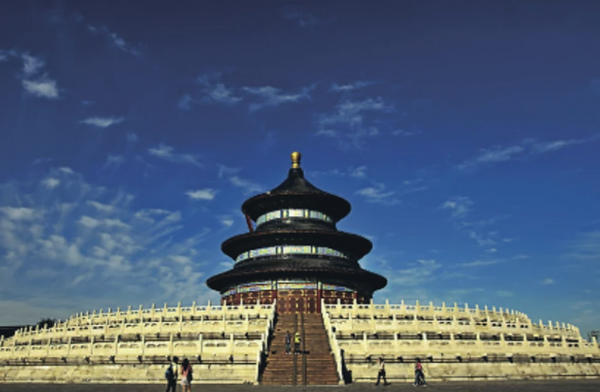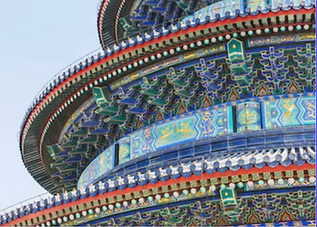NEXT STOP HEAVEN!

As soon as I saw The Temple of Heaven, I thought it looked like some form of giant transmitter pointing to the Heavens.
My first impression of a transmitter was pretty close. Master Cheng explained that the Temple is believed to be a medium for humans on Earth to communicate with Heaven. Its position on the grounds is said to have been divined by the Emperor's Feng Shui masters as the exact point where heaven meets Earth, and it is one of the many important medians between Earth and Heaven.
As I found out, it was also a receiver! The emperors received signs through dreams and met unexplained events after praying in the temple. It is said that Heaven informs, advises, or reminds the emperor about something in the form of these signs.
I stood in the center of the space and felt I could be teleported straight to heaven, and for a few glorious moments felt I had been.I wondered what my dreams would hold for me.
The whole building is completely wooden, and no nails were used in the construction as it is felt that nailing is a violent action.
Master Cheng explained, ‘The brilliant artisans of the Qing Dynasty built supernatural sites - according to the science of acoustics, and the walls of the temple have a unique feature. The ancient Chinese engineers designed and carefully built the walls with two layers so that the walls are thick and able to produce an echo effect.’ There are three doors. If a bell was rung, you could hear it through the three doors. The doors and long pathways are built so that the echoes produced are able to pass through these long pathways.
The vibrations of the echoes amplify the good Ch'i in the temple.
I am sure there are many secrets to be unfolded here if one knows Taoist philosophy and Feng Shui. We were fortunate as Master Cheng shared many insights.
I wondered what my dreams would hold for me.
There is so much genius behind the design and construction of The Temple of Heaven, I could have spent months absorbed in unfolding the knowledge it embodied and still only scratched the surface (of the knowledge, not the temple!)
It is recognised as one of the most brilliant ancient architectures in China, an outstanding masterpiece of classic imperial buildings throughout Chinese history, one of the largest sacrificial sites in the world, not only in size and scale but also in the forms and traditions.
It was a great fortune to be in the company of a Master who could open my eyes to many of the subtleties and "messages" built into the Temple, and I left feeling we had had a visit to Heaven on Earth.
Master Cheng explained that the combination of these shapes allows good Ch'i to flow in from outside and above, and entrap the good Ch'i inside
Inside, the circular design of the Temple of Heaven surrounded us, creating a feeling of well-being and being nurtured.
At the same time, I was absorbing the incredible, colorful visuals and subtleties of sublime craftsmanship. The colors used are unlike most Imperial buildings, where the roofs are golden – all the buildings within the Temple of Heaven have special dark blue roof tiles to represent the sky (heaven). In Feng Shui, colors also play an important part in attracting and generating Ch'i.
When the emperor prayed for his citizens, the Good Ch'i Flow could then flow outside and reach the citizens, returning the Good Ch'i flow to the citizens.

THROUGH THE GATES OF HEAVEN ON EARTH
Master Cheng stood in the center of the vast courtyard and started to point out a few 'Feng Shui' features, the graceful curves, the use of octagonal shapes to soften the sharp corners so often used in Western buildings, and whose sharpness pokes us like 'energy arrows' on subtle levels. A moat was both defensive and brought the vitality and flow of water into the location, and, seen from above, takes the form of a Dragon.
The use of wood in construction had the most auspicious connotations for buildings representing Spring and Life. The carpenters used interlocking mortise and tenon joints to build the great palace buildings, and nails were considered violent and inharmonious (a feature of many of the ancient temples).
The stone of the grand terraces was another insight into the ingenuity of the engineers. It had been transported from quarries near Beijing; wells were dug along the way, and water from the wells was poured on the road in winter, forming a layer of ice. The stones were then dragged along the ice,
"Look at what you are standing on," Master Cheng said inside one of the halls. The floors of major halls were paved with six-century-old original 'golden bricks', baked with clay; each batch would have taken months to bake, resulting in smooth bricks that actually rang with a metallic sound.
Sharing more folklore, Master Cheng said there are a total of 9,999 and a half rooms in the Forbidden City because only the God of Heaven is entitled to 10,000 rooms. Emperor Chengzu, who built the Forbidden City, declared himself the son of the God of Heaven, explaining the smaller size of his palace.
The use of colour and the reasons why is also very interesting
The prominent color scheme is red walls and yellow roof tiles. The yellow symbolizes earth elements at the center, the Emperor believed the Imperial Palace is at the world's center, and his reign radiated out from it. Pillars, windows, doors, and walls were mostly red symbolizing auspicious events and happiness.
The beauty and opulence of the buildings was stunning, and it was yet another experience to enter the twisting pathways of the Imperial Garden, like entering a Chinese fairy tale. It was a world of 'wise'ancient trees, rock outcrops, waterfalls, flowers, scattered and hidden among them elaborately decorated gazebos, together all generating a beautiful sense of harmony.
Huge weathered boulders in a variety of shapes and sizes called 'Scholar’s rocks', were selected for when rain cascades down them bringing them to life with vitality as a beautiful art form.
Above the garden is an occasional view of one of the large imperial residences, which in the lush setting looks like an exotic castle out of some ancient legend.
I left following a path paved with varied patterns made of colored pebbles, symbolizing luck and fortune, feeling a little like Alice must have felt in Wonderland.

Were these massive doors a portal to experiencing Heavenly peace?
Like the best concierge, Master Cheng gracefully ushered us through the giant red gates of the Forbidden City into a vast courtyard, breathtaking examples of traditional Chinese colossal architecture featuring superb creativity and craftsmanship: upturned roofs adorned with figures from Buddhist history and Chinese mythology, elaborately carved walls, and pillars painted Imperial red.
The largest ancient palatial structure in the world, I believe it is a portal as much as a palace. The sounds and the smells seemed to linger from the past and conjured up images of emperors and concubines in glorious robes in breathtaking scenes of beauty and refinement, heavenly music, and rich incense.